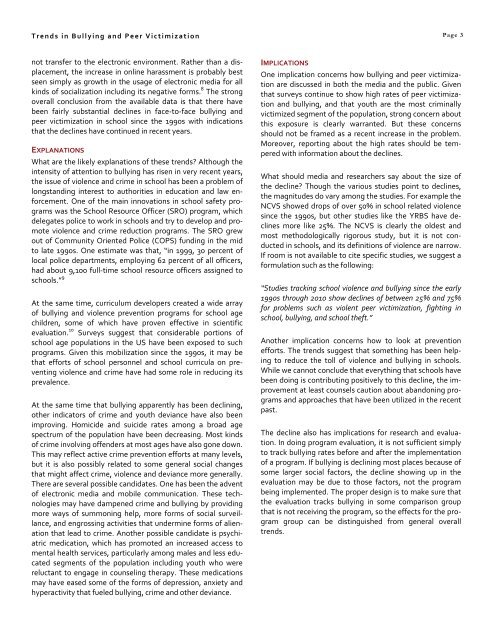Create successful ePaper yourself
Turn your PDF publications into a flip-book with our unique Google optimized e-Paper software.
Trends in <strong>Bullying</strong> and <strong>Peer</strong> <strong>Victimization</strong> Page 3<br />
not transfer to the electronic environment. Rather than a displacement,<br />
the increase in online harassment is probably best<br />
seen simply as growth in the usage of electronic media for all<br />
kinds of socialization including its negative forms. 8 The strong<br />
overall conclusion from the available data is that there have<br />
been fairly substantial declines in face‐to‐face bullying and<br />
peer victimization in school since the 1990s <strong>with</strong> indications<br />
that the declines have continued in recent years.<br />
EXPLANATIONS<br />
What are the likely explanations of these trends? Although the<br />
intensity of attention to bullying has risen in very recent years,<br />
the issue of violence and crime in school has been a problem of<br />
longstanding interest to authorities in education and law enforcement.<br />
One of the main innovations in school safety programs<br />
was the School Resource Officer (SRO) program, which<br />
delegates police to work in schools and try to develop and promote<br />
violence and crime reduction programs. The SRO grew<br />
out of Community Oriented Police (COPS) funding in the mid<br />
to late 1990s. One estimate was that, “in 1999, 30 percent of<br />
local police departments, employing 62 percent of all officers,<br />
had about 9,100 full‐time school resource officers assigned to<br />
schools.” 9<br />
At the same time, curriculum developers created a wide array<br />
of bullying and violence prevention programs for school age<br />
children, some of which have proven effective in scientific<br />
evaluation. 10 Surveys suggest that considerable portions of<br />
school age populations in the US have been exposed to such<br />
programs. Given this mobilization since the 1990s, it may be<br />
that efforts of school personnel and school curricula on preventing<br />
violence and crime have had some role in reducing its<br />
prevalence.<br />
At the same time that bullying apparently has been declining,<br />
other indicators of crime and youth deviance have also been<br />
improving. Homicide and suicide rates among a broad age<br />
spectrum of the population have been decreasing. Most kinds<br />
of crime involving offenders at most ages have also gone down.<br />
This may reflect active crime prevention efforts at many levels,<br />
but it is also possibly related to some general social changes<br />
that might affect crime, violence and deviance more generally.<br />
There are several possible candidates. One has been the advent<br />
of electronic media and mobile communication. These technologies<br />
may have d<strong>amp</strong>ened crime and bullying by providing<br />
more ways of summoning help, more forms of social surveillance,<br />
and engrossing activities that undermine forms of alienation<br />
that lead to crime. Another possible candidate is psychiatric<br />
medication, which has promoted an increased access to<br />
mental health services, particularly among males and less educated<br />
segments of the population including youth who were<br />
reluctant to engage in counseling therapy. These medications<br />
may have eased some of the forms of depression, anxiety and<br />
hyperactivity that fueled bullying, crime and other deviance.<br />
IMPLICATIONS<br />
One implication concerns how bullying and peer victimization<br />
are discussed in both the media and the public. Given<br />
that surveys continue to show high rates of peer victimization<br />
and bullying, and that youth are the most criminally<br />
victimized segment of the population, strong concern about<br />
this exposure is clearly warranted. But these concerns<br />
should not be framed as a recent increase in the problem.<br />
Moreover, reporting about the high rates should be tempered<br />
<strong>with</strong> information about the declines.<br />
What should media and researchers say about the size of<br />
the decline? Though the various studies point to declines,<br />
the magnitudes do vary among the studies. For ex<strong>amp</strong>le the<br />
NCVS showed drops of over 50% in school related violence<br />
since the 1990s, but other studies like the YRBS have declines<br />
more like 25%. The NCVS is clearly the oldest and<br />
most methodologically rigorous study, but it is not conducted<br />
in schools, and its definitions of violence are narrow.<br />
If room is not available to cite specific studies, we suggest a<br />
formulation such as the following:<br />
“Studies tracking school violence and bullying since the early<br />
1990s through 2010 show declines of between 25% and 75%<br />
for problems such as violent peer victimization, fighting in<br />
school, bullying, and school theft.”<br />
Another implication concerns how to look at prevention<br />
efforts. The trends suggest that something has been helping<br />
to reduce the toll of violence and bullying in schools.<br />
While we cannot conclude that everything that schools have<br />
been doing is contributing positively to this decline, the improvement<br />
at least counsels caution about abandoning programs<br />
and approaches that have been utilized in the recent<br />
past.<br />
The decline also has implications for research and evaluation.<br />
In doing program evaluation, it is not sufficient simply<br />
to track bullying rates before and after the implementation<br />
of a program. If bullying is declining most places because of<br />
some larger social factors, the decline showing up in the<br />
evaluation may be due to those factors, not the program<br />
being implemented. The proper design is to make sure that<br />
the evaluation tracks bullying in some comparison group<br />
that is not receiving the program, so the effects for the program<br />
group can be distinguished from general overall<br />
trends.




